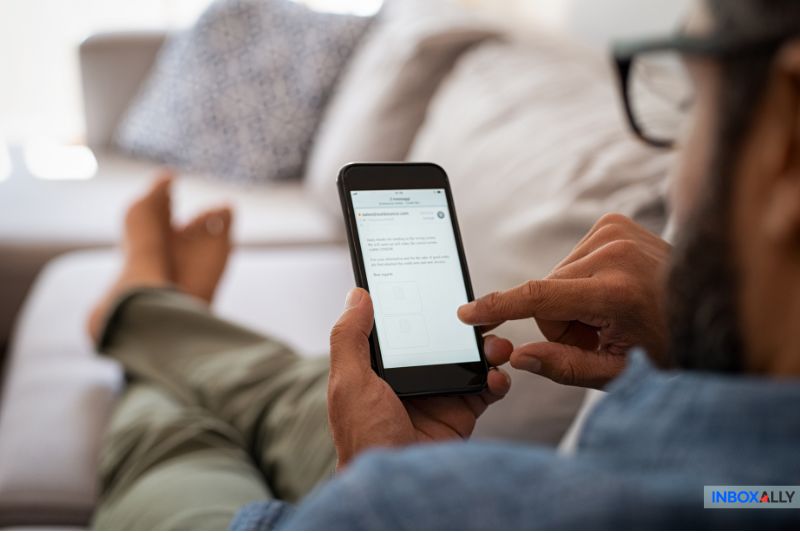Most cold emails end up in the spam folders or trash – never to be seen again.
Why?
These cold emails (also known as unsolicited emails) are untargeted, and so many recipients wonder how they even landed in their inboxes. They lack attention to detail, making the sender appear like a cheeky spammer.
Still, we can’t deny that cold email marketing is incredibly effective. It is among the most used platforms for reaching new customers and clients.
That’s why we’re on a crusade to save your cold email from landing in the spam.
In this guide, you’ll learn how to write a cold email that captures your prospect’s attention and achieves your desired outcome. But first, let’s start with the basics in the section below.
Do People Open Cold Emails?
Absolutely, yes – but only if you get it right.
In fact, the average open rate for cold emails is between 40% to 60%. Furthermore, sending cold emails is a numbers game: the more emails you send, the higher the chance of success.
However, not everyone will respond to cold emails, and you cannot just spam your recipients. Below are a few writing tips to increase your open rate and engagement.
Topic You’ll Love: How to Send Mass Emails Without Landing in Spam
The Art of Cold Emailing: 25 Tips for Writing Effective Cold Emails
1. Find Your “Why”
First things first: Get clear on your “Why.”
Why do you want to do cold email outreach? What’s your objective? Is it to reach a wider audience? To improve sales? To promote brand value?
Remember that hundreds of emails flood your prospects’ inboxes every day. Your campaign could fail if you’re unsure what you want to achieve.
So, write down your intention first, and the rest of the ideas will flow.
2. Understand Your Audience
Crafting a cold email that stands out starts with truly understanding who you’re reaching out to. A well-researched audience makes it easier to create messages that feel relevant and engaging, boosting your chances of getting a response.
For example, millennials (born between 1981 and 1996) often prefer email as their go-to communication channel over cold calls, making cold emailing an effective strategy for this demographic.
To ensure your emails resonate, focus on building a targeted list of recipients who align with your niche or industry. Reaching out to people who genuinely care about your products or services increases the chances of sparking interest and building connections.
Understanding the broader context of email marketing can also help refine your approach. Exploring the email marketing advantages and disadvantages will ensure you create more effective and targeted campaigns.
3. Identify Their Challenges/ Pain Points
To write an effective cold email, you must also research and thoroughly identify your recipient’s pain points. Understanding their struggles and unique challenges will help you write content that speaks to them.
Stay updated with industry news, explore significant online forums, and visit social media.
We also suggest you avoid lengthy introductions. Instead, go straight to your potential client’s pain point and personalize your cold email to resonate with their needs. Doing so will help you attract the user’s attention.
The Pain Point + Solution Formula
The technique behind this cold email formula is to describe a common problem related to people in their industry. The more targeted and specific you can be about their pain point, the better.
Next, describe how your service or product can easily and quickly provide an immediate solution and finish your campaign with a strong close with the next step they should take.
4. Split Up Your Contacts
Many cold emails fail (easily get marked as spam) because they’re sent as email blasts, have not undergone audience analysis, and are not segmented.
Therefore, an essential cold email tip is to split up your contacts and create buyer personas of your potential customers.
You can include their:
- demographics,
- job or responsibilities,
- buying characteristics,
- how they feel or think,
- where they are in your customer journey, and
- their unmet needs
5. Begin With an Outline
The key to a successful cold email is outlining the points you wish to discuss before writing. Doing so will help you organize and construct ideas in a thoughtful flow and sequential manner. It will help you write content that makes sense to the recipient.
Even if you have only a few sentences to write, think of
- the main goal you want to achieve,
- an appealing introduction that will make your recipient read your email and
- the question you want to ask.
Only then should you start crafting your cold email. Which leads us nicely to…
6. Ask a Question
Asking a question in cold email campaigns is a great way to catch users’ attention and entice them to open your email.
It’s even more effective when you ask an open-ended question relevant to their buyer persona and put this question in the subject line.
Why? If they want the answer, they’re more likely to open the email to find it if it strikes an emotional chord, even better since emotion motivates people to take action, such as making a purchase decision.
Joy, amusement, awe, and relief are good emotions to trigger in a cold email. When done right, it can generate a high open rate.
7. Customize Your Email
Including your recipient’s name or personalizing your cold emails helps you stand out in a crowded inbox. After all, people are naturally drawn to their names.
For instance, if you’re a photographer looking to reach out to clients, these photographer email templates provide a great starting point to craft tailored, compelling messages that resonate with your audience.
A study about how personalized subject lines affect email open rates even showed that personalizing with the prospect’s name had the highest average open rate (43.41%) compared to personalizing with the company’s name (35.65%). [1]
8. Create Mobile-Friendly Cold Email Subject Lines
By following the suggestions above, you’re well on your way to a winning subject line.
Here’s another important tip to consider: Ensure that it is relevant, short, and mobile-friendly.
What’s the point of writing a compelling subject line if it gets cut off because it’s too long? We recommend keeping the subject line around 40 characters to make it readable on different devices.
A subject line can have about 40 to 70 characters on a desktop or tablet, but mobile devices only allow 30 to 60 characters.
9. Be Buyer-Centric
Of course, your prospects need to know about your brand, product, or service. But more importantly, they need you to tell them what it can do for them. How can it make their business more successful? Will it fix their problem?
Being buyer-centric with your cold email also means leading with “you” rather than “I.” For instance, write “Your question on [website name] …” instead of “I’m also a member of [website name].”
10. Keep It Short and Simple
Shorter emails significantly outperform emails with longer copy.
So, it’s best to keep your emails short and simple. Being polite is important, but try to remove unnecessary greetings. The three main elements that your emails should contain are the following:
- Who you are
- What you offer, and
- The action you want your recipient to take
11. Inject Humor
A Litmus study found that email marketers have approximately three seconds to grab a recipient’s attention before they delete a message. [2]
Adding humor or funny trigger words to your cold email subject lines or content helps you stand out and showcases your brand’s personality. When your service or product is uplifting, personal, playful, and fun, there’s room for a casual, fresh tone to engage with readers.
12. Strike the Right Tone
Successful cold email outreach involves opening the email and maintaining the right tone for the rest of the message. If you make it too salesy, you may offend the target audience, which isn’t ready yet to purchase or avail themselves of the service.
Don’t be obnoxious or aggressive. And don’t trash-talk your competitors in the industry.
It doesn’t leave room to sell yourself and will reflect poorly on your brand. Your email tone should also come across as equal, not know-it-all.
13. Use Embedded Instead of Hosted Photos
You have two options for including images in emails. You can either host the image externally and link it to the content or embed it directly in your email.
While most email clients display photos without significant issues, some still show images as attachments. That’s why we recommend embedding them to simulate a real email.
Topic You’ll Love: Cold Email vs. Spam – The Key Differences
14. Avoid Attachments
Send cold emails without attachments because they only make them heavier, alerting the anti-spam filters. If that happens, your cold emails will go to the junk folder.
Rather, add a link to specific pages where your prospects can see added information.
15. Have a Clear Value Proposition
As much as possible, focus on only one key benefit per campaign. You don’t want to bore, confuse, or overwhelm your readers with every product feature or share your life story.
Instead, only share certain details, like the benefits your product brings to your prospect’s needs or problems.
16. Provide Relevant Social Proof
Highlight previous successes from clients similar to your target audience. For instance, “We’ve already helped [company name 1 in the same industry] and [company name 2 in the same industry] double their sales while remaining cost-efficient.”
Of course, the strongest form of social proof in email marketing is a mutual connection. Having a mutual friend means you’re not a stranger.
If you have any credibility, social status, or authority important to your recipient, mention it quickly. The more you mention it, the more likely your message will get a response.
17. Don’t Rely too Heavily on Templates
Don’t sound like a robot by relying heavily on templates. Use them wisely if you need to improve your consistency while saving time.
But tailor the cold email template or tweak it to make it sound like you wrote it. Adjust the context, language, and tone if necessary.
18. Give Them An Out
Your email should also contain an option for recipients to opt-out, in compliance with email marketing laws in various jurisdictions, such as the CAN-Spam Act in the US and the GDPR in Europe.
Remind your recipients that whether they respond is ultimately their choice. This technique builds your credibility and trust as a sender and doubles your chance that your recipients will say yes to your offer.
19. Employ Double Unsubscribe Opt-in
Aside from making it easy for your subscribers to opt out of future emails if they want to, a good cold email strategy is to employ a double unsubscribe opt-in.
It’s an option to confirm a user’s subscription via a landing page or a separate email to officially add them to your list.
This process boosts users’ interest levels, lessens the risk of spam, and prevents accidental unsubscribes.
20. Make Your CTA Clear and Easy To Follow
Make your call-to-action (what you’re mainly asking for) clear.
Do you want them to tell you what they thought about your linked video? To introduce your brand to their colleague? To schedule a demo? Or perhaps we can speak about your recent research? If possible, limit it to one ask per campaign.
A CTA is an important part of a cold email, but that doesn’t mean you should include too many. Overloading your email with multiple CTAs is like proposing marriage on a first date—it’s overwhelming and off-putting. Instead, stick to one clear and focused CTA to guide your readers toward the action you want them to take.
21. Check Your Grammar and Punctuation
Not everyone is a stickler for proper grammar and punctuation, but you can’t tell who is who isn’t when sending a cold email.
First impressions matter. Correct grammar and punctuation make you look professional, attentive, and credible. Another benefit is that it helps you avoid miscommunication and helps you clearly explain what you mean.
22. Include Your Email Signature
Finish your email with a professional email signature to help you build a human connection and trust with the recipient. It likewise increases your chance of getting a response.
Your email signature should contain your full name, company name, role in the company, and contact information. You may include your best Instagram captions or other social media links, especially if you send them as a brand.
Topic You’ll Love: How to Cold Email Without Hurting Email Reputation
23. A/B Test Your Cold Emails
Regularly optimize and measure factors from subject line angles to email timing to ensure the best deliverability and open rates. Test various subject lines, call-to-actions, and content to see what works best and what needs to be improved.
Topic You’ll Love: Cold Email Experts Share What’s Working for Them – 16 Tips and Hacks Combined
24. Schedule Your Campaign
It’s wise to schedule your campaign to be sent out when your recipients will be most receptive and engaged. This email marketing strategy is especially important for your first cold email campaign.
The good news is most cold emailing platforms now allow users to schedule their emails. Perhaps you want your campaign to land in your recipient’s inboxes first thing in the morning, around lunch, or late afternoon. Whatever you think is right, schedule accordingly.
25. Use an Email Deliverability Tool
You’re almost done. The next strategy to boost your campaign is to use a reliable email deliverability tool or cold email software.
With just a few clicks, the software will more likely send personalized emails to a larger audience. It also allows easy targeting and segmentation, so you can tailor your campaign to a certain audience and ultimately increase engagement.
A great way to improve deliverability is with InboxAlly. It’s a unique email deliverability tool that teaches inbox providers like Gmail and Yahoo Mail to understand that recipients value your cold emails.
We’ll help you get your emails in the inbox right from the start. It’s simple to set up and free to get started. Start your free trial today.
How To Structure a Cold Email
Of course, this guide on how to write cold emails wouldn’t be complete without sharing the ideal email structure that gets more opens and replies.
1. Subject Line
Your subject line will have a huge impact on whether your prospects will open your email or not. Remember – it’s the first impression you make on your prospects. Here are some best practices to incorporate.
- Keep your subject line short and sweet. Convey your message effectively in about 5-7 words.
- Use strong verbs to encourage the prospects to take action and/or evoke a sense of urgency.
- Avoid spam-trigger words like “limited time offer” and “free” because they may make your campaign appear spammy. Instead, focus on emphasizing the benefits and creating value.
2. Email Body
Avoid overwhelming your cold email recipients with a lengthy email. Keep focused and brief, and ensure it’s easy to understand and read. As much as possible, stick to a single objective or idea and provide all the details the reader needs to act.
3. CTA
This part of your email moves your prospects down the sales funnel. You can achieve this by scheduling a call, booking a meeting, or signing up for a free trial. A compelling and strong call to action is necessary for a successful cold email campaign.
Cold Email Examples
Let’s be honest; this is how most cold email templates sound…
| Subject: Helping [Their Company Name] Reach New Heights in [Industry] Hi [Recipient’s Name], I hope this message finds you well. I’m [Your Name], and I lead the [Your Position] at [Prospect’s Company]. We specialize in [briefly describe your services/products] designed specifically for [their industry] like yours. I came across [mention how you found out about their company or any recent achievement/news] and thought there might be a great fit between [Their Company Name] and [Your Company Name]. We’ve worked with businesses like [mention any common connections, similar businesses, or local competitors], helping them to [mention key benefits; e.g., increase sales, reduce costs, improve customer satisfaction]. I’d love to share a few ideas about how we can help [specific problem or opportunity you can help with]. Are you available for a brief call [suggest a specific time frame, like ‘next week’]? It would be great to learn more about your needs and discuss potential solutions. Thank you for considering this. I’m looking forward to the possibility of working together to create something outstanding for [Their Company Name]. Kind Regards, [Your Name] [Your Position] [Your Company Name] [Contact Information] [Website URL] |
This cold email template ticked some boxes we highlighted earlier, such as identifying the prospect’s challenges or pain points.
But did you make it to the end of the email? Or can you picture your client hitting the back button before the end? Let’s see how you could improve on the standard cold email template.
Business-to-Business Cold Email Template
Example 1:
| Subject: Can [Their Company Name] Outsmart the Usual Suspects in [Industry]? Hi [Recipient’s Name], Is your inbox as tired of the same old sales pitches as you are? I’m [Your Name], the [Your Position] at [Your Company Name], where we help [briefly describe your services/products] with a twist. I’ve been watching [Their Company Name] grow, and I must say, you’re doing some incredible work in the [specific aspect of their industry]. But the question is: Are you getting the support you need to tackle [specific challenge they might be facing]? How are you currently managing [specific challenge or process related to your service/product]? I’d love to catch up for a quick chat to discuss a strategy that boosts efficiency and keeps your competitors guessing (and maybe a little jealous). What do you say about a brief call to exchange some ideas? How about this Thursday at 10 AM? If that’s too soon, just give me a shout—it’s about time your inbox had something to look forward to! Eager to chat soon, [Your Name] [Your Position] [Your Company Name] [Contact Information] [Website URL] |
Example 2:
| Subject Line: Is it time for a [Your Industry] Upgrade? Let’s Explore! Hello [Recipient’s Name], Imagine this: [a scenario where your product/service solves a big problem for them]. Sounds a bit too good? Well, it’s perfectly possible with a little help from [Your Product/Service] at [Your Company]. I’m [Your Name], and I’ve helped people like yourself in [their industry or interest area] turn the ordinary into the extraordinary. Whether it’s enhancing efficiency, reducing costs, or simply getting the peace of mind you deserve, our solutions are tailored to bring you measurable results. Here’s an idea – let’s have a chat for about 15 minutes. I think you’ll find our insights into [a specific problem or opportunity] quite enlightening. What do you say? Can we schedule a virtual coffee next Tuesday or Wednesday? Alternatively, I can send over a summary of our [Product/Service] for you to look at in your own time. Thank you, [Recipient’s Name], for considering this. I’m looking forward to potentially sparking some great changes! Warm regards, [Your Name] [Your Job Title] [Your Phone Number] [Company Website URL] |
As the example above shows, a cold email can be professional and engaging. In fact, if your email’s going to convert, it has to stand out as different. Remember, you aren’t talking to a robot, so don’t write like one. Your tone should be conversational and motivate the reader to hit the reply button.
Here is an example of a good follow-up email.
B2B Follow-Up Email Template
Example 1
| Subject Line: Can We Help Knock Out Those Pain Points? Hey [Prospect’s Name], Just a quick follow-up to my last email. I hope I’m not catching you in the midst of a post-lunch food coma! Do you have any thoughts on how [Your Solution/Service] might fit into your toolkit? I’m all ears and ready to brainstorm. Let’s join forces and put those pain points in their place once and for all. What do you say? Looking forward to hearing from you, [Prospect’s Name]! Best, [Your Name] [Your Position] [Your Contact Information] |
Example 2:
| Subject Line: Quick Reminder: Ready to Explore [Your Product/Service]?
Hi [Recipient’s Name], I just wanted to pop back onto your radar following my last email. I’m really excited about the possibility of showing you how [Your Product/Service] can make a [specific benefit] a reality for you. I’d love to grab those 15 minutes we talked about to dive a little deeper into your needs and discuss how we can help. Please let me know a time that works for you or if there’s another way you’d prefer to learn more about what we do. Looking forward to hearing from you! Best regards, [Your Name] [Your Job Title] [Your Contact Information] [Company Website URL] |
Conclusion
Now you know the techniques for writing cold emails that prompt action and get you more leads. As mentioned, an important piece of the puzzle that can help you get more done in less time is the right email deliverability tool.
With InboxAlly, you can double your open rates within 1-2 weeks. It has helped thousands of email marketers, mailing list owners, deliverability experts, email service providers, and agencies save time and improve their sender reputation.






